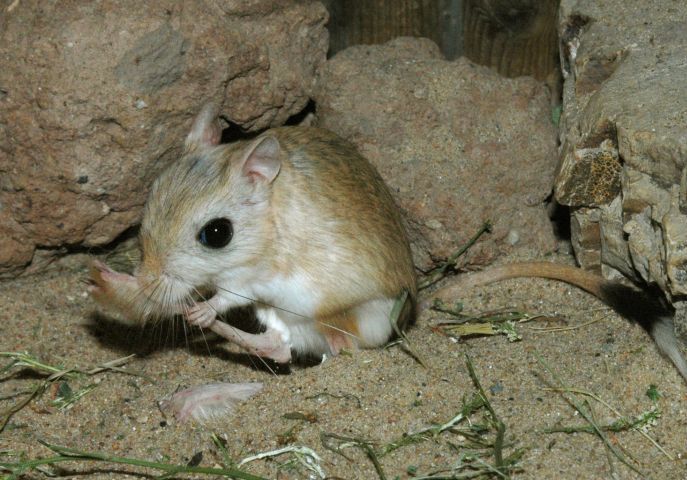
Northern three-toed jerboa (Dipus sagitta)
Phylum — chordata
Class — mammalia
Order — rodentia
Family — dipodidae
Genus – dipus
Appearance
The Northern three-toed jerboa has a head-and-body length of 100 to 155 mm (4 to 6 in) and a tail of 145 to 190 mm (5.7 to 7.5 in). The weight is between 56 and 117 g (2 and 4 oz).
The upper parts are ochre-brown to reddish-brown, a white band stretches from the base of the tail across the hips, and the underparts are white. The long tail has a terminal tassel which is black with a white tip.
Habitat
This jerboa has a range extending from the Don River and the Caspian Sea region, through Turkmenistan, Uzbekistan, Northern Iran and Kazakhstan, to Mongolia and Northern China.
Behavior
The Northern three-toed jerboa either lives alone or in pairs. It occupies an extensive home range in which there may be several burrows, several shallow temporary burrows and one main deep burrow. The animal excavates the tunnel with its fore limbs, using its teeth to cut roots, and pushes soil out with its hind feet or nose, forming a characteristic fan-like mound of waste material.
The species is nocturnal and emerges after dark. It moves bipedally, normally making hops that are about 10 to 15 cm (4 to 6 in) long, but making great bounds of 120 to 140 cm (47 to 55 in) when agitated.
Diet
This animal forages primarily for seeds, but also eats grasses, shoots, leaves, bulbs, roots and insects.
Reproduction
Breeding takes place during the summer with two or three litters, each averaging three or four young, being produced after a gestation period of 25 to 30 days.
In captivity
Life expectancy in captivity is up to 4 years.
It is convenient to keep it in large aquariums (from 1, 2x0, 25 m and more), covered with a mesh top. There is also laid out some turf, about one-third of the height of the room. The sand is necessary: ordinary river sand is sifted through a soil sieve with the smallest mesh. The resulting dust is the most suitable in this case. It is not worth keeping animals in aquariums with sandy soil only. Sand very quickly gets dirty because the remnants of feed, and the skin of animals becomes greasy; it is difficult to change the sand daily (sifting it) and takes a lot of time.
When keeping animals in captivity, it is always very important to choose the right food diet, so that the animals receive all the necessary vitamins, salts and other components that abound in their natural food. Jerboa in this regard are quite a difficult group, since, on the one hand, they are very conservative in nutrition, on the other - the plants that make up the basis of their diet are characteristic only of steppes and deserts, and in other zones they have to choose full-fledged substitutes. In addition, these rodents are characterized by a distinct seasonality of nutrition, so that in the autumn-winter season, they eat juicy food very reluctantly.
Jerboa willingly eat sunflower seeds, watermelons, melons, pumpkins, oats, wheat, rye, corn, fresh bread, carrots, beets, potatoes, apples, dandelion greens.
 Russian
Russian
 English
English


















